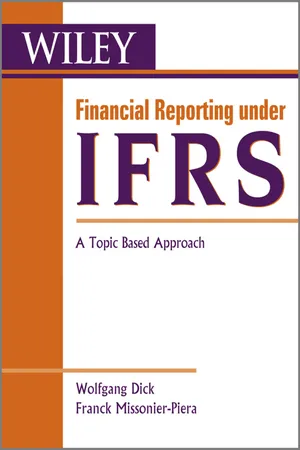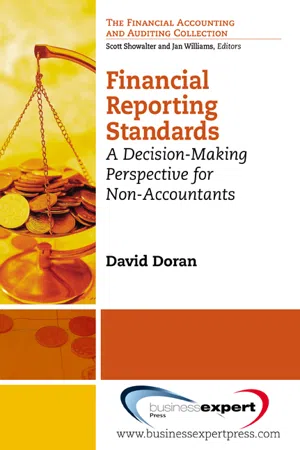Economics
Liabilities
Liabilities in economics refer to the financial obligations or debts that an individual, company, or government owes to others. They can include loans, mortgages, unpaid bills, and other financial responsibilities. Liabilities are recorded on a company's balance sheet and are important for assessing the financial health and stability of an entity.
Written by Perlego with AI-assistance
Related key terms
5 Key excerpts on "Liabilities"
- eBook - ePub
Wiley Guide to Fair Value Under IFRS
International Financial Reporting Standards
- James P. Catty(Author)
- 2010(Publication Date)
- Wiley(Publisher)
23 LiabilitiesKARRILYN WILCOXCANADAINTRODUCTION
A liability is a legal or constructive obligation resulting from past events or transactions, the settlement of which leads to a probable cash outflow and may also include future economic costs; another view is that a liability is a present obligation to transfer assets or provide services in the future. Liabilities are normally classified as either current (due within one year or a normal operating cycle, whichever is longer) or term (noncurrent). The International Financial Reporting Standards (IFRS) requires separation into current or noncurrent unless a liquidity-based presentation is more relevant, such as for banks. Well-known examples of Liabilities include bank loans, accounts payable, commercial paper, pension plan obligations, and bonds. Changes in law or actions by an entity can cause the timing of the event to differ from that of the liability. For example, a change in environmental laws can result in a liability for the cleanup of a polluted site years after the related actions.TYPES OF Liabilities
There are various sources of Liabilities. A brief discussion of several of the more common Liabilities, identified as current or term, is presented next.Current Liabilities
• Accounts payable or trade credits. Occur when a firm purchases goods from another and does not pay cash immediately for them.• Unearned revenue. Created when an entity collects cash in advance of providing goods or services.• Notes payable. Reflect amounts owed to creditors, either on demand or a fixed date; they may also be noncurrent if the maturities are greater than one year• Provisions. Estimates of Liabilities that have not yet crystallized (e.g., a lawsuit that has not been settled).• Accruals - eBook - ePub
Financial Accounting
A Concepts-Based Introduction
- David Kolitz(Author)
- 2016(Publication Date)
- Routledge(Publisher)
past transactions or events. As mentioned above, the purchase of goods gives rise to accounts payable, and the receipt of a loan gives rise to an obligation to repay it.The settlement of an obligation involves an outflow of future economic benefits in order to satisfy the claim of the other party. Settlement of a present obligation may occur in a number of ways. These include:• payment of cash;• transfer of other assets;• provision of services;• replacement of that obligation with another one.A distinction needs to be drawn between a present obligation and a future commitment. A decision to acquire assets in the future does not, of itself, give rise to a present obligation.Pause and reflect…
Do accounts payable meet the definition of a liability?Response
Accounts payable are an obligation of the entity (the obligation to pay the amount owing to the suppliers), as a result of a past event (the purchase of the goods on credit), the settlement of which is expected to result in an outflow from the entity of resources embodying economic benefits (cash will be paid to the suppliers). Accounts payable therefore do meet the definition of a liability.Equity
Equity is the residual interest in the assets of the entity after deducting all its Liabilities.Equity is often referred to as the net assets or net wealth of the entity. Assume that a business entity has assets of C10 000 000 and Liabilities of C4 000 000 at 31 December 20X5. The assets of C10 000 000 are resources controlled by the entity and the Liabilities of C4 000 000 represent the obligation of the entity to outside parties. The residual of C6 000 000 is the equity or the owner’s interest in the entity. - eBook - ePub
- Steven Collings, Maire Loughran(Authors)
- 2013(Publication Date)
- For Dummies(Publisher)
In Chapter 7, I walk you through the assets part of the accounting equation. This chapter is all about the claims, or debts, which in accounting lingo are called Liabilities. Nobody likes debt, but it’s often an inevitable part of a company keeping its doors open for business. In this chapter, I cover both current and long-term debt. You find out what types of current Liabilities help a business manage its day-to-day operations, and you learn about long-term debt obligations that businesses use to acquire assets. I cover basic long-term debt such as mortgages and loans, and I also discuss a method many companies use to raise finance – issuing bonds – focusing on the facets of this complicated topic. A third type of liability – contingent Liabilities – also gets a mention in this chapter. These Liabilities aren’t always included in financial accounting reports, so I give you the lowdown on when and how to include them. Seeing How Businesses Account for Liabilities Liabilities are claims against the company by other businesses or its employees. Examples include: Trade payables (often called trade creditors): Money a company owes to its suppliers for services rendered and products it has purchased. Deferred income: Money received from clients that pay the business for goods or services they haven’t yet received – like advance payments for subscriptions. Salaries payable: Salaries the company owes to employees. Generally accepted accounting practice (GAAP, which I discuss in Chapter 4) dictates that when you prepare the liability section of the balance sheet, any claims against the company have to be broken down between current and long-term obligations. The dividing line between the two is the one-year mark: all Liabilities that are due within one year of the date of the financial statements are considered current - eBook - ePub
Financial Reporting under IFRS
A Topic Based Approach
- Wolfgang Dick, Franck Missonier-Piera(Authors)
- 2011(Publication Date)
- Wiley(Publisher)
4NON-FINANCIAL LiabilitiesOrdinary (or current) activities of the company often generate many obligations (Liabilities). For example, when a company does not immediately pay its purchases of goods, it records a debt towards its supplier. It therefore has an obligation to pay its bill at a later date. This chapter discusses the various Liabilities of a company, except those related to its financing. They are mainly Liabilities towards suppliers, staff or the State. They can be classified into three categories:• Liabilities are obligations whose motive, due date and amount payable are known (i.e. all the characteristic features of other Liabilities, such as trade payables or accruals).• Provisions are obligations whose motive is known, but not the exact amount nor the due date. The amount to be recorded as Liabilities is then determined using reliable estimates.• Contingent Liabilities are potential obligations whose existence is confirmed by the occurrence of one or more uncertain future events, which are not totally under the control of the company.The plan of this chapter follows this classification (see Figure 4.1 ).The excerpt of the Liabilities section of the balance sheet of the 2008 TOTAL Group highlights the diversity and volume of the Liabilities of a large group (see Figure 4.2 ). We can note that the non-current financial debts amount to €16,191m. The notes to the consolidated accounts state that they are essentially bonds amounting to €13,665m.Just above appear the other non-current items (provisions and other Liabilities) for €17,842m. Finally, the current Liabilities appear for €34,327m. - eBook - ePub
- David T. Doran(Author)
- 2012(Publication Date)
- Business Expert Press(Publisher)
CHAPTER 5 Liabilities: Current, Contingent, and Long-Term Debt IntroductionIn this chapter we initially discuss Liabilities and related issues in general . The topic of leases is covered in the next chapter. Debt instruments are discussed from the borrower’s perspective here, but the same concepts apply from the lender’s perspective, which will be discussed in chapter 7 —Investments. Recall from chapter 1 that in financial analysis Liabilities are compared with assets in order to assess a firm’s liquidity, solvency, and financial flexibility. As we discussed in chapter 1 , Liabilities are the opposite of assets and represent “probable future economic sacrifices as a result of past transactions and events.“ Although the “future sacrifice” typically requires cash payment (e.g., accounts payable, taxes payable, salaries and wages payable, etc.), it may require providing goods or services (i.e., unearned revenue). An understanding of the accrual accounting principles (revenue and expense recognition) is necessary to comprehend liability recognition. Under the accrual basis of accounting, revenue is included in the income statement of the period earned (regardless of when the cash is received) and costs associated with revenue of the income statement period are expensed (regardless of when the cash is paid).Executory contracts (also called unexecuted contracts) are those where parties each agree to provide consideration (something of worth) in the future, but neither party has provided anything yet. Executory contracts are generally not considered to constitute “past transactions or events,” and therefore are not typically recognized in the financial statements. For example, if a corporation enters into a contract with its CEO to provide $12 million in exchange for her services during the next fiscal year, nothing
Learn about this page
Index pages curate the most relevant extracts from our library of academic textbooks. They’ve been created using an in-house natural language model (NLM), each adding context and meaning to key research topics.




